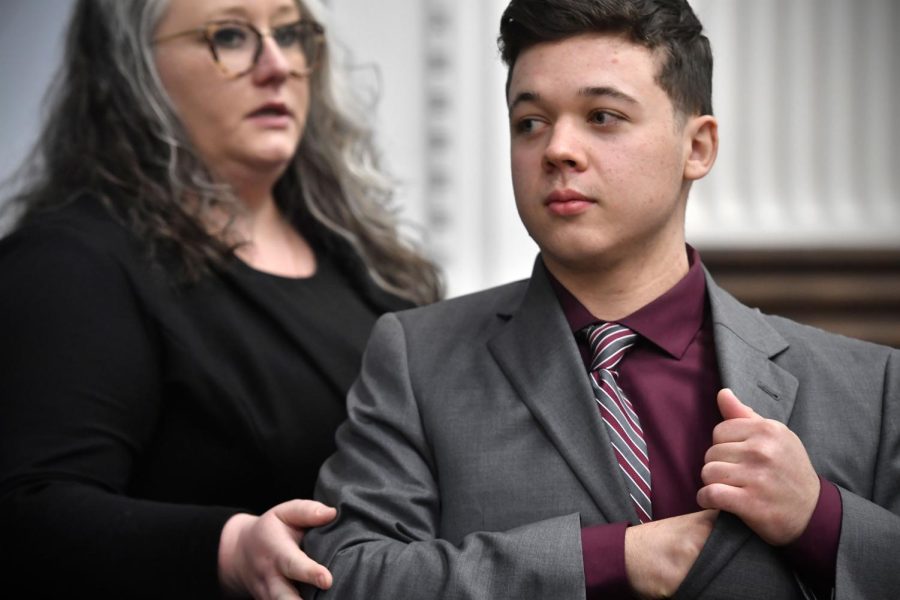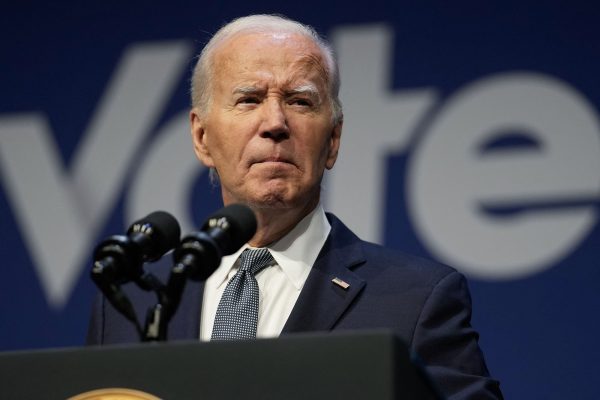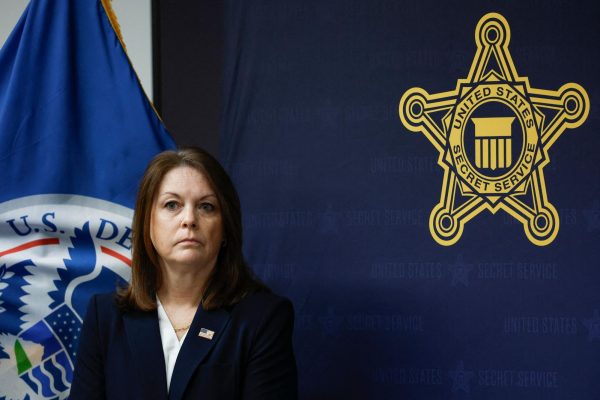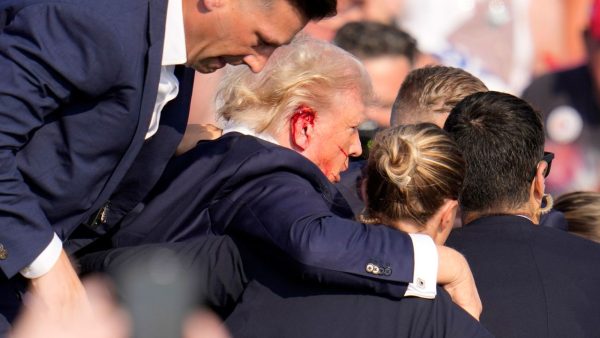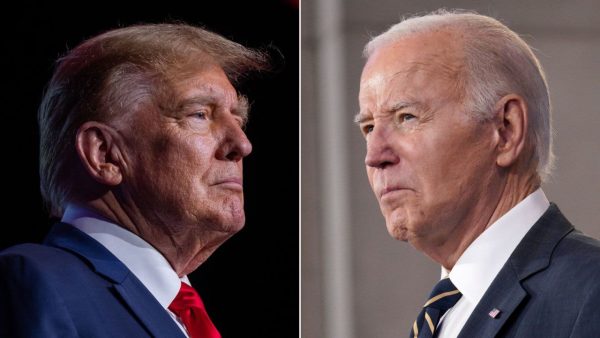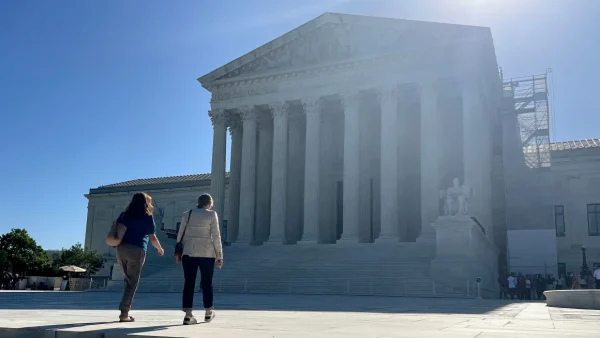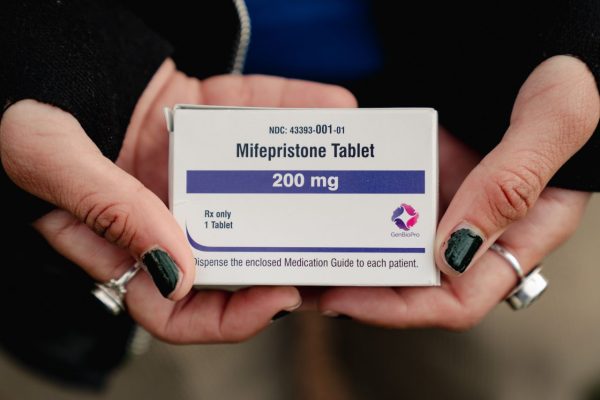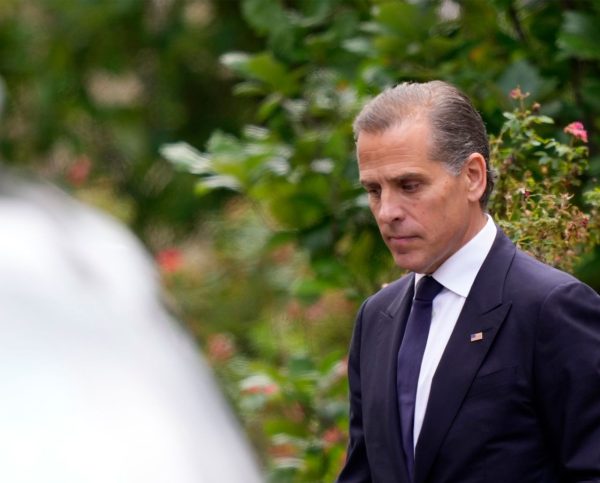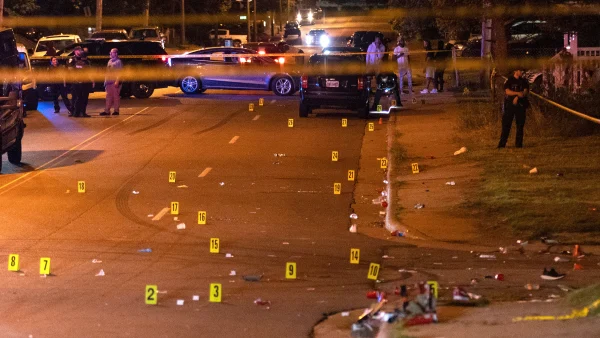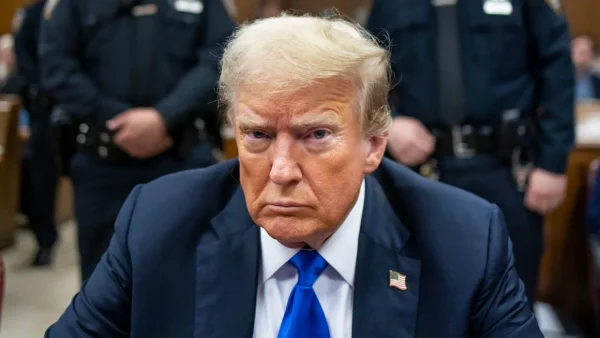Prosecution rests its case against Kyle Rittenhouse and judge dismisses curfew violation charge
Kyle Rittenhouse, right, puts a pen in his pocket and looks to the gallery as his attorney Natalie Wisco moves him toward the door during a break in the trial at the Kenosha County Courthouse in Kenosha, Wis., on Thursday, Nov. 4, 2021. Rittenhouse is accused of killing two people and wounding a third during a protest over police brutality in Kenosha, last year. (Sean Krajacic/The Kenosha News via AP, Pool)
November 10, 2021
(CNN) — The prosecution on Tuesday rested its case against Kyle Rittenhouse in his homicide trial after calling 22 witnesses over the course of six days, giving the defense its first opportunity to call witnesses.
The state’s 21st witness was a forensic imaging specialist with the state crime lab in Milwaukee who played drone footage of Rittenhouse fatally shooting Joseph Rosenbaum. Their final witness was a doctor who testified that Rosenbaum died from a fatal shot to the back as his body was bent forward.
Once the prosecution rested, Judge Bruce Schroeder agreed to dismiss a curfew violation charge against Rittenhouse, ruling that prosecutors had failed to present any evidence a curfew was in place.
The defense then called four of its own witnesses Tuesday, including two armed people who went to Kenosha the night of the shootings. The defense will resume its case Wednesday and could call Rittenhouse to take the stand.
The testimony has at times favored the prosecution’s case that Rittenhouse committed five felonies and a misdemeanor in Kenosha, Wisconsin, on the night of August 25, 2020. Yet other evidence — sometimes from the same witness — has bolstered the defense’s argument that Rittenhouse, then 17, acted in self-defense when he opened fire.
The events of that night, almost all captured on video, are hardly in dispute: Rittenhouse, armed with an AR-15-style rifle, fatally shot Rosenbaum — who was chasing the teenager and threw a plastic bag at him — and then shot at three other people who confronted him. Rosenbaum and Anthony Huber were killed, and Gaige Grosskreutz was wounded.
The question before the jury, rather, is whether Rittenhouse’s actions are to be considered reasonable or criminal.
Rittenhouse fired his rifle eight times in all during the chaotic protests following the police shooting of Jacob Blake. He shot Rosenbaum four times; fired twice at an unknown person who tried to kick him; fatally shot Huber, who had hit him with a skateboard; and shot Grosskreutz, armed with a gun, in the arm.
Rittenhouse, now 18, pleaded not guilty to six charges, including first-degree intentional homicide, first-degree reckless homicide and first-degree attempted intentional homicide.
The prosecution called 15 witnesses last week made up of police, witnesses who filmed the shootings and armed men out in Kenosha that night. Five other witnesses testified on Monday, highlighted by Grosskreutz, and two more testified on Tuesday.
Defense witness says armed group was asked to protect building
Nicholas Smith, the defense’s first witness, testified that Anmol “Sam” Khindri, one of the owners of the Car Source car dealership, had asked him to help protect the dealership on the night of the shootings.
Smith’s testimony contradicted Khindri and his brother, who both said on Friday they never asked anyone to protect the car lot.
Smith, 23, said he had worked at Car Source previously and was friends with the owners for nearly 10 years. He said he reached out to Rittenhouse’s friend, Dominick Black, after he came across a video posted to Snapchat showing Black at the protests the night before.
Through Black, Smith said he met Rittenhouse, who loaned him his body armor for the night of August 25, 2020. Smith said that he was on the roof of the dealership when he heard gunshots and did not see the shootings. He testified that Rittenhouse appeared sweating and pale afterward.
“He repeats, ‘I just shot someone,’ over and over, and I believe at some point he did say he had to shoot someone,” Smith said.
The defense also called JoAnn Fiedler, an armed woman who traveled to Kenosha the night of the shootings, and Nathan DeBruin, a freelance photojournalist who took photos of the unrest.
Fiedler testified that Rittenhouse was pale, shaking and stammering his words after shooting the men. She described Rittenhouse “pulling his hair back and pulling it back really hard and just, his comment was, ‘my God, my life might be over’ and just, we’re just like, ‘OK, calm down.'”
Key witness admits he pointed gun at teen
One of the prosecution’s most important witnesses — the paramedic shot and wounded by Rittenhouse — testified Monday.
Grosskreutz, a paramedic out that night, testified that he believed the teenager was an active shooter and so pursued him and unholstered his own concealed firearm. He testified that he put his hands up when Rittenhouse pointed his AR-15-style rifle at him but believed Rittenhouse did not accept his surrender. Rittenhouse shot him in the right bicep.
“I was never trying to kill the defendant,” Grosskreutz said. “In that moment, I was trying to preserve my own life, but doing so while taking the life of another is not something I am capable or comfortable doing.”
However, Grosskreutz also admitted that he pointed his gun at Rittenhouse before he was shot.
“When you were standing three to five feet from him with your arms up in the air, he never fired, right?” defense attorney Corey Chirafisi said.
“Correct,” Grosskreutz said.
“It wasn’t until you pointed your gun at him, advanced on him with your gun — now your hand is down pointed at him — that he fired, right?” Chirafisi asked.
“Correct,” Grosskreutz responded.
In addition, the paramedic testified that his concealed carry license was expired that night. He also admitted he incorrectly told investigators his gun had fallen out of his pants earlier in the night.
Aggressors or victims?
While the prosecution has sought to show Rittenhouse as a criminal gunman, defense attorney Mark Richards said Rittenhouse fired only in self-defense. In opening statements, he described Rosenbaum as the aggressor in the initial shooting and said Huber and Grosskreutz were part of a mob who “attacked him in the street like an animal.”
To make their case, the defense has repeatedly focused on what one witness described as Rosenbaum’s “erratic” behavior that night. Cellphone and surveillance videos show he threw a plastic bag at Rittenhouse and chased him across a parking lot before the teenager shot him.
Other video from earlier in the night showed Rosenbaum yelling, “shoot me (n-word).” One of the armed men said Rosenbaum had acted “belligerently” and another said he had threatened to kill him and Rittenhouse.
“He goes, ‘You know, if I catch any of you guys alone tonight, I’m gonna f***ing kill you,'” according to Ryan Balch, a military veteran who brought his weapon into Kenosha that night.
However, the prosecution noted that none of the other armed men that night had shot at Rosenbaum and said that the men killed by Rittenhouse were the only people killed during the protests.
Rosenbaum had just been released from the hospital that morning, his fiancée Kariann Swart testified. She said he was on an antidepressant as well as medication to treat bipolar disorder.
Richie McGinniss, a video editor with The Daily Caller news site, testified that Rosenbaum had lunged for the front of Rittenhouse’s rifle moments before he was shot.
“It was as if, you know, if you were to lunge at somebody, if anybody were to lunge, they would probably stop themselves, you know, from falling face down on the ground, but the shots were fired in the exact instance that his momentum was going forward and that continued until Mr. Rosenbaum landed on the ground,” McGinniss said.
McGinniss was just feet from the two when Rittenhouse opened fire. He said he jumped out of the line of fire and then shook his legs out to make sure he hadn’t been hit.
“Given where I was, certainly I was in danger,” he said.
His testimony is key to one of the charges against Rittenhouse — a felony count of first-degree recklessly endangering safety.
Doctor testifies on autopsies
On Tuesday, a forensic pathologist testified that Rosenbaum was first shot in the front, bent forward into a horizontal position, and then was hit by a fatal bullet to the back.
Dr. Douglas Kelley with the Milwaukee County Medical Examiner’s Office testified that Rittenhouse shot Rosenbaum four times — twice in the front, once in the back and once along the side of his head. Video of the shooting shows Rittenhouse fired at Rosenbaum’s front, so Kelley determined that the fatal shot to his back came as his body leaned forward.
“The only time during the interaction in which he could have incurred the gunshot wounds to the back and to the right side of the head was when he was more horizontal, and the only time that happens is the last two gunshot wounds,” Kelley said. “The first two gunshot wounds are represented by the injury to the groin and the injury to the left thigh.”
Kelley said that horizontal position is consistent with a person either falling forward or lunging at someone. He also noted that Rosenbaum had a close-range gunshot wound to his hand.
“That hand was over the barrel of Mr. Rittenhouse’s gun when his hand was shot?” defense attorney Richards said.
“That makes sense,” Kelley responded.
The-CNN-Wire
™ & © 2021 Cable News Network, Inc., a WarnerMedia Company. All rights reserved.


